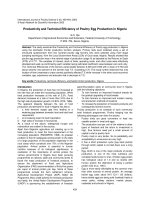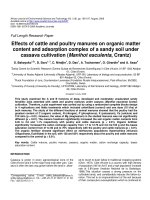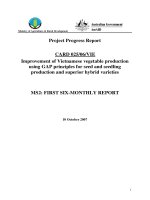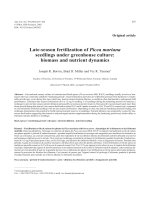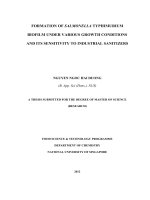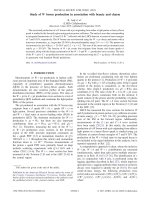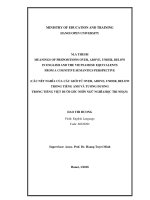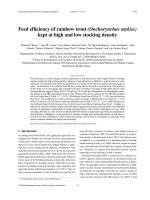Comparisons of tilapia seed production under various broodstock densities and fry stocking densities
Bạn đang xem bản rút gọn của tài liệu. Xem và tải ngay bản đầy đủ của tài liệu tại đây (4.34 MB, 22 trang )
Comparisons of Tilapia Seed
Production Under Various Broodstock
Densities and Fry Stocking Densities.
G.W. Glenney* 1, G.S. Libey2
Department of Fisheries and Wildlife Sciences
2
Virginia Polytechnic Institute and State University
Blacksburg, VA 24061 USA
Corresponding author, present address:
*2071 Old Highway 12
1
Starkville, MS 39759 USA
ABSTRACT
Three types of seed (eggs, sac-fry, and fry) production for Rocky
Mountain White® hybrid tilapia, (0. niloticus x 0. aureus), were
compared under green water conditions over a six-month period in an
environmentally-controlled greenhouse at the Virginia Tech Aquaculture
Center. Rectangular tanks were stocked with broodstock (mean wt. 680
g), at a sex ratio of 3 females to I male. Nine tanks were stocked at one
of three densities ( 1, 2, and 4 females/m 2 ), and seed was collected from
the females' mouths weekly. Three additional tanks were stocked at a
density of 2 females/m 2 , and fry were collected from the edges of the
tanks daily.
Average number of viable fry produced by the clutch removal method
at 1 female/m 2 was significantly higher than the combined average
production of densities at 2 and 4 females/m 2 (p< 0.02). Even though
there was no significant difference between viable fry production per
meter sq. (p>0.05), the highest density consistently produced more fry/
m 2 • No significant difference was observed in viable fry production
International Journal of Recirculating Aquaculture, Volume 3
11
between the clutch removal method and the natural mouth-brooding
method (p>0.05). The mean monthly hatchery seed survival was 65.7 ±
2.3%, which varied largely depending on initial seed developmental
stage.
The effects of stocking density on growth and survival were evaluated
by stocking 14-16 day old artificially incubated fry (25.5 ± 0.32 mg, 12.1
± 0.04 mm), into 150-liter troughs at three densities (3, 6, and 12 fry/
liter) under green water conditions for 30 days.
Significant differences were observed between mean weight, length,
survival, and feed conversion ratios among the various fry stocking
densities (p<0.05). The greatest growth was at a density of 3 fry/liter,
while survival was not affected until a density of 12 fry/liter was
reached.
These results suggest that to maximize fry production and reduce
labor, a density of 4 females/m 2 or higher be used under the natural
mouth-brooding seed collection method. They also suggest a fry
stocking density between 6 to 12 fry/liter should be used with periodic
grading or sex reversal to reduce cannibalism and increase growth.
INTRODUCTION
In the past thirty years, tilapia (Family Cichlidae) have become one of
the most important groups of fish to the worldwide aquaculture industry
(Lovell 1980). Tilapia often exhibit rapid growth rates, are easily
reproduced, have a desirable white, flaky flesh, and express high
tolerance to many of the environmental stresses associated with
recirculating aquaculture practices. Tilapia are generally considered
extremely prolific; however, being mouth brooders, the number of eggs
per clutch tends to be relatively low. This complicates the collection of
large numbers of "seed" (eggs or sac-fry) of the same developmental
stage for production purposes.
Two different seed collecting methods are commonly used. The first
method entails collecting the fry after the brooding females have released
them. The second involves periodically removing the seed clutches from
the brooding females' mouths. The removal of seed from a mouth-
12
International Journal of Recirculating Aquaculture, Volume 3
brooding female can reduce the inter-spawning interval by half (Rana
1988). By freeing the female of mouth-brooding and fry protection, she
can resume feeding and condition herself more rapidly for the next
spawning cycle. Berrios-Hernandez and Snow (1983) felt that the egg
removal method was not worth the additional time investment, since
there was no significant difference between seed numbers in the two
collection methods. However, Watanabe et al. (1992) concluded that the
clutch removal method, even though more labor intensive, yielded higher
numbers of viable fry. They attributed the lower fry numbers in the
natural mouth-brooding to cannibalism.
Tilapia markets are developing outside of traditional equatorial
regions. Indoor recirculating aquaculture systems (RAS) have made it
possible to expand tilapia production to the temperate zones. Further
information is needed for year-round intensive fry production to
efficiently supply tilapia producers using RAS.
The objectives of this study were to compare fry production among
various broodstock densities under green water conditions, to compare
the clutch-removal method and natural mouth-brooding fry collection
methods in terms of fry production and to compare the growth and
survival of swim-up fry at various stocking densities for thirty days
under green water conditions. Stickney (1994) defines green water
conditions as "the maintenance of sufficient concentrations of
phytoplanktonic algae in the culture tanks of the aquaculture target
species to provide a green color".
MATERIALS AND MElHODS
The study was conducted in an environmentally-controlled greenhouse
at the Virginia Tech Aquaculture Center in Blacksburg, Virginia (USA).
The tilapia used for the study were the "Rocky Mt. White" hybrid (0.
niloticus x 0. aureus).
Environmental Maintenance
Eighteen 200-Watt incandescent bulbs were used to establish a 12: 12
light-dark photoperiod (Rothbard and Pruginin 1975). The lamps were
controlled with dimmer switches to produce a fifteen-minute artificial
International Journal of Recirculating Aquaculture, Volume 3
13
sunrise and sunset. Lamp use was discontinued when the natural
photoperiod exceeded a 12: 12 photoperiod. Three 300-Watt heaters were
used in each tank to maintain spawning temperatures between 25 to
30° C (Rothbard and Pruginin 1975). Water quality parameters were
measured daily (Temperature, DO, pH), every other day (TAN, AlgaeAbsorbance), or weekly (Nitrite, Nitrate, Alkalinity, Hardness) by
standardized Hach procedures. Algae concentrations were measured
with a Hach 1800 spectrophotometer (Hach Company, Loveland, CO,
USA) set at 750nm (absorbance), to establish relative means for
comparison (Standard Methods, 1992). Water quality was managed to
maintain parameters according to the following criteria: dissolved
oxygen concentration-> 5.0 ppm, ammonia (NH 3 )- < 0.2 mg/I (TLC)
(Daud et al. 1988), nitrite- <0.5 ppm, nitrate- < 500 ppm, alkalinitybetween 20 to 300 ppm , hardness-> 50 ppm (Buttner et al. 1993).
A 1.0 Hp. regenerative blower supplied aeration using airstones. The
broodstock tanks were managed as a green water algae system. Each
tank was siphoned every two weeks with a one-third water exchange.
Phytoplankton blooms were managed by water flushes to flatten out
population cycling. All broodfish were fed a 40% protein floating pellet
(Zeigler Bros. Inc., U.S.) to satiation three to four times daily.
Broodfish Density
Four treatments were established by arbitrarily stocking a total of 108
broodfish, (male- mean wt. 853.9 ± 40.3 g, mean total length 33.9 ± .70
cm; female- mean wt. 508.8 ± 18.2 g, mean total length 29.3 ± .29 cm),
into twelve polyvinyl-lined broodtanks (2.4 X 1.2 x 0.6 m). The fish
were individually passive integrated transponder (PIT) tagged, weighed,
and stocked at a sex ratio of one male per three females (BerriosHernandez and Snow 1983; Snow et al. 1983; Santiago et al. 1985;
Subasinghe and Summerville 1992; Watanabe et al. 1992). Spawning
activity was observed within ten days of stocking. On February 1, all
females' mouths were emptied of seed to initiate the study. Seed
production was compared by establishing three replicates per density
( 1.0 female/m 2, 2.0 females/m 2, and 4.0 females/m 2), using nine tanks.
14 International Journal of Recirculating Aquaculture, Volume 3
Seed Collection Methods
Nine tanks were managed under the clutch removal method, and
sampled every seven days (Verdegem and McGinty 1987). At sampling,
a fine meshed bottom net was lowered at one end of the tank. After
being crowded over the bottom net, each fish was individually dip
netted, identified, and the female's mouths were checked for seed. If no
seed was present, the females were checked for internal eggs by gentle
abdominal pressure, while the males were checked for milt by manual
stripping. A bottom net was used to collect uncontrolled seed expulsion
by brooding females. The collected seed was segregated by
developmental stages: eggs, or sac-fry. All broodfish in these tanks were
weighed monthly when sampling for seed.
The three remaining tanks were stocked with broodfish at a density of
2.0 females/m 2 • Fry were collected after the females completed the
natural mouth-brooding process. Each tank possessed sloping wings on
each end to provide a location for the fry to congregate (Figure 1). A net
barrier was placed at the beginning of the slope to establish the same
surface area for breeding as the nine clutch removal tanks. A 38 mm
mesh size net allowed for the passage of fry but prevented broodfish
from entering the wing area. The wing area of these tanks was inspected
daily for swim-up fry, which if present, were collected and counted.
Broodfish in these tanks were weighed at the beginning and end of the
experiment.
Clutch Removal Method
Figure I. Side view of
broodfish tanks- breeding
area (2.4 x 1.2 x 0.6 m).
a.- Sloped area for fry to
congregate.
b.- 38 mm mesh net
barrie1:
Natural Mouth Brooding Method
International Journal of Recirculating Aquaculture, Volume 3
15
B.
l c.
I
......... ,.,
IA. I
F.
~
~
~,
G.
=7
Figure 2. Side view of hatchery system used to incubate tilapia eggs. Arrows indicate
the direction of water flow. A.- Pump. B.- 1.27 cm ball valve. C.- Seven liter roundbottom hatching jar. D. - Swim-up fry catch basin. E. - Stand pipe and fry mesh screen.
F.- Water reservoir. G. - Activated carbon filter, a corrugated tube filter, and ultraviolet
irradiation. H.- Over-flow valve.
Hatchery
The hatchery consisted of nine 7-liter round-bottomed up-welling
hatchery jars (Rana 1986) (Figure 2). The water was filtered and
sterilized by an aquarium filtration unit at 47 liter/min. The unit
contained an activated carbon filter, a corrugated tube filter (16 micron),
and a 25-Watt ultraviolet irradiation bulb (Subasinghe and Summerville
1985; Don et al. 1987). The hatchery was cleaned once a week along
with a 75% water exchange. The sterilization unit was cleaned every
two weeks. Make-up (well) water for the hatchery was stored and
maintained between 25-30 ° C. with immersion heaters (Subasinghe and
Summerville 1992). The hatchery unit was managed as a clear water
system. The collected eggs from each tank were segregated by
developmental stage. The eggs were counted using grids. After
counting, the eggs were placed in hatching jars (400-8,000 eggs/jar). An
arbitrary composite sample of sixty eggs was taken from all the eggs and
measured and weighed. During incubation, dead eggs were removed to
deter fungal growth. Upon swim-up, the fry were counted to estimate
hatching success.
16
International Journal of Recirculating Aquaculture, Volume 3
FryRearing
A randomized block design consisting of four trials was used. Each
trial consisted of nine 300-liter fry troughs, each divided into two 150liter sections. Three replicates were conducted within each trial. The fry
were stocked at densities of 3, 6, and 12 fry/liter, with each density being
arbitrarily stocked twice per replicate (Watanabe et al. 1992; Dambo and
Rana 1992). Dechlorinated make-up (city) water was stored and heated
to 25-30°C with 200-Watt immersion heaters. Each fry trough was
siphoned twice daily with a water exchange of two-thirds the total
volume. The fry troughs were managed as a green water algae system.
The same water quality parameter regime was used as the breeding trials
above. A 1.0 Hp. regenerative blower supplied aeration using airstones.
Swim-up fry (6-8 days post-swim-up) were pooled from the hatchery,
and measured for average length (mm) and weight (mg). The fry were
fed a 55% protein salmon starter (Zeigler Bros. Inc., Gardners, PA, USA)
to satiation four to five times a day, and as size increased, a 44% protein
semi-floating diet (Rangen Inc., Buhl, ID, USA) was used. Each trial
lasted for thirty days. At the end of the thirty days, an arbitrary sample
of sixty fish was taken from each 150-liter density section per replicate
and measured and weighed. Total counts were estimated by weight to
determine survival by treatment.
Statistics
Analysis of variance (split plot design) was used to statistically
analyze for differences between the mean numbers of eggs produced per
female/month and per meter sqlmonth at the various broodstock
densities over time. Orthogonal contrasts were conducted to establish
which specific broodstock densities differed in terms of egg production
per female/month and per meter2/month.
Analysis of variance was used to analyze the difference between the
mean seed numbers produced per female/month and per meter2/month by
the two seed collection methods: clutch removal at seven day intervals,
and natural mouth brooding with daily fry collection.
Analysis of variance (randomized block design) was used to
statistically analyze for differences between the means of fry length and
weight among the three fry stocking densities. Tukey' s multiple
International Journal of Recirculating Aquaculture, Volume 3
17
comparison analysis was conducted to establish which specific fry
stocking densities differed in terms of their effects on growth by testing
the significance of variation among mean length and weight.
RESULTS
Density comparisons, dutch removal seed production
Four water quality parameters (D.O., pH, Absorbance, and Hardness)
changed significantly through time for the three broodfish densities (1.0
female/m 2, 2.0 females/m 2, 4.0 females/m 2) over the 180-day study
period (p< 0.05). However, there were no significant differences
between treatments over time for all water quality parameters (p>0.05)
(Table 1).
No significant difference was observed in cell abundance between the
dominant populations of planktonic green algae, Scenedesmus and
Eudorina (identified by Dr. Bruce Parker of Virginia Tech), or between
treatments throughout the entire sampling period (p>0.05).
Seed production continued throughout the 180-day study period
among all treatments. Monthly fry production per female and per meter
sq. was compared among density treatments. There were no significant
Figure 3. Mean fry production per female by treatment for the six-month study period.
A significant difference was observed by contrasting a combination of treatments 2
and 4 femaleslm 2 against treatment 1 female/ m2 (p<0.02).
--....
3000~-----------------~
2500 ...............................................
........
~
2000
1500
1000
~
4 Femalesim.
-
2 Femaleslm. sq.
._........_ l Femalesim. sq.
500
0+-----ll-----+-----+----+-----1
Febrnary
March
April
['.fay
June
July
Month
18
SlJ.
International Journal of Recirculating Aquaculture, Volume 3
Table 1. Broodstock tank water quality parameter means, ± S.E., and ranges by density treatment. ( D.O., Temp. (°C), pH, TAN, NHY N02 , NOY
Alkalinity, Hardness (mgll), Absorbance (at 750 nm). No significant difference between treatments was observed (p>0.05).
1 Female/m2
-..,
::l
,....
ro
2 Female/m2
4 Female/m 2
Mean
S.E.
Range
Mean
S.E.
Range
Mean
S.E.
Range
5.7
26.2
7.8
0.371
0.0137
0.044
6.07
122.0
129.0
0.259
0.1
0.1
0.05
0.032
0.0026
0.008
0.55
8.0
7.0
0.021
1.9
1.8
0.6
0.634
0.0143
0.107
11.45
107.0
90.0
0.289
5.4
26.2
7.7
0.424
0.0178
0.051
5.69
103.0
125.0
0.259
0.1
0.2
0.05
0.04
0.0049
0.008
0.47
6.0
5.0
0.017
1.4
2.5
0.6
0.789
0.0305
0.107
6.78
87.0
69.0
0.261
5
25.9
7.5
0.478
0.0134
0.082
10.86
77.0
133.0
0.28
0.1
0.2
0.07
0.021
0.0049
0.007
0.93
7.0
4.0
0.021
1.8
2.0
1.0
0.321
0.0299
0.121
13.05
94.0
55.0
0.309
::l
,......
......
~
0
Dissolved Oxygen
'--<
0
Temperature
::l
pH
_,
TAN
::l
e:..
..,i::
e:..
0
;;o
ro
CJ
..,.
Un-ionized (NH3)
n
i::
Nitrite (N02)
~-
Nitrate (N03)
>--
Alkalinity
n
e.,....
Hardness
i::
Absorbance (algae)
~
,....
'§
~
N
0
S'
--+
g
(ti
I»
:::!.
=
0
Table 2. Fry production per female and per meter sq., expressed as monthly means and± S.E. by density treatment (Expressed as number offry
after swim-up from hatchery). No statistically significant differences were observed over time in fry production per female or per meter sq. for
all treatments (p>0.05). A statistical significant difference was observed infry production per female between treatments with a time interaction
(p<0.05). Fry production per meter sq. was not statistically significant between treatments (p>0.05).
!!!..
......
0
c:
!!!..
Fry/female
0
.......
~
(ti
n
Mean S.E.
r:;·
n
E.
I»
--+
s·
Otl
.g>
$!ll
n
E.
e,..,
!D
<
0
[
(ti
w
Two Females/m2
One Female/m2
g
February
March
April
May
June
July
309
1095
1650
1872
2537
2497
309
285
631
740
399
355
Fry/m2
Mean S.E.
309
1095
1650
1872
2537
2497
309
285
631
740
399
355
Fry/female
Four Females/m2
Fry/m2
Fry/female
Fry/m2
Mean
S.E.
Mean
S.E.
Mean
362
724
836
626
788
439
83
83
79
301
223
167
723
1448
1670
1250
1575
877
166
165
157
601
444
334
374
594
767
891
73
176
3072
3560
763
108
781
113
3050
292
706
432
3122
452
S.E. Mean
S.E.
1497
2376
225
772
56
193
differences in fry production per female or per meter sq. for all
treatments through time (p>0.05) (Table 2). However, there were
significant differences in fry production per female between treatments
with a time interaction (p<0.05). Orthogonal contrasts were conducted
between treatment densities. There was a significant difference when
treatments 2 and 4 females/m 2 were combined and contrasted against
treatment 1 female/m2• (p<0.02) (Figure 3). Differences in fry
production per meter sq. were not significant between treatments
(p>0.05).
Mean condition factors were calculated monthly by tank and compared
(condition factor= weight/length 3) (Piper et al., 1982). A significant
difference was observed through time for all treatments (p<0.05).
However, no significant differences were observed between treatments
or between treatments with a time interaction (p>0.05).
Weekly seed production status was determined by treatment.
Observations were categorized by the presence of seed, and if present,
developmental stage. The females within the density of 1 female/m 2
collectively produced seed 35% of the time. At the two higher densities
of 2 females/m2 and 4 females/m 2, seed was produced 22 and 25% of the
time, respectively. Females of all treatments without seed possessed
Table 3. Fry production per female and per meter sq., expressed as monthly means and
± S.E. by egg collection method (Expressed as numbers offry after swim-up from
hatchery for clutch removal method). No statistically significant difference was
observed in fry production per female or per meter sq. between the two seed collection
methods (p>0.05 ).
Clutch Removal Method
Two Females/ml
Fry/female
Fry/ml
Mean S.E.
February
March
April
May
June
July
362 83
724 83
836 79
626 301
788 223
439 167
Mean
723
1448
1670
1250
1575
877
S.E.
166
165
157
601
444
334
Natural Mouth-Brooding Method
Two Females/ml
Fry/female
Fry/ml
Mean
221
433
732
654
579
502
S.E.
133
297
282
250
345
156
Mean S.E.
443 267
865 594
1463 563
1306 499
1156 690
1004 313
International Journal of Recirculating Aquaculture, Volume 3
21
internal eggs about 60% of the time. While milt was rarely visible, it
was seen 5% of the time in the two higher densities. The males in the
lowest density never expressed visible milt.
OutchRemoval vs. NaturalMouthBrooding
No significant differences were observed in water quality parameters
between the two seed collection treatments (p>0.05) except for the
parameter alkalinity (clutch removal method- mean 102, ± 3.2 mg/l; and
natural mouth brooding method- mean 115, ± 3.6 mg/l) (p<0.05).
Significant differences were not observed in fry production per female or
per meter sq. between the two collection methods (clutch removal
method- monthly mean of 629 fry/female, 1257 fry/m2 ; and natural
mouth brooding method- monthly mean of 520 fry/female, 1039 fry/m2)
(p>0.05) (Table 3).
Hatchery
The hatchery was maintained and operated throughout the six-month
sampling period. Mean water quality parameters were: temperature
(26.8 ± l.89°C), dissolved oxygen (5.9 ± 0.83 mg/l), pH (8.5 ± 0.23),
TAN (0.342 ± 0.312 mg/l), alkalinity (311 ± 52.6 mg/l), and hardness
(488 ± 89.7 mg/l).
Mean monthly survival for unpigmented eggs (< two days old) was
37.2 ± 3.4%, 70.2 ± 2.6% for pigmented eggs (>two days old), and 89.7
± 1.2% for sac-fry (non-swimming) to yolk-sac absorption. The monthly
mean hatchery survival for all three seed stages combined to yolk-sac
absorption was 65.7 ± 2.3%. The weekly mean egg weight was 6.22 ±
Table 4. Fry weights and lengths, expressed as means, and± S.E. by stocking density
(30 day trial). Means within the same column followed by different letters are
significantly different (p<0.05 ).
Weight (grams) Mean
S.E.
Length (mm)
Mean
S.E.
3 fry/liter
1.85
0.048 a
3 fry/liter
42.90
0.35 a
6 fry/liter
1.62
0.043 b
6 fry/liter
41.15
0.329 b
12 fry/liter
1.42
0.039 c
12 fry/liter
39.26
0.309 c
22
International Journal of Recirculating Aquaculture, Volume 3
0.030 mg, while the mean major axis was 2.59 ± 0.006 mm.
Fingerling density, gro~ and swvival
No significant differences were observed in all water quality
parameters between stocking densities 3 fry/liter, 6 fry/liter, and 12 fry/
liter (p>0.05). Significant differences were observed between mean
length and weight among treatments, with a density of 3 fry/liter
showing the highest growth. (p<0.05) (Table 4 ).
A significant difference was observed in survival rates between fry
densities, but was not seen until a density of 12 fry/liter was reached
(p<0.05) (Table 5). A significant difference was also observed in feed
conversion between fry densities. However, feed conversion was not
significantly reduced until a density of 12 fry/liter was reached (p<0.05)
(Table 5).
DISCUSSION
Density comparisons, dutch removal seed production
The numbers of viable fry obtained per female and per meter sq.
in this study are among the highest reported for intensive tilapia
production (Berrios-Hernandez and Snow 1983; Guerrero and Guerrero
1985; Lovshin and Ibrim 1987; Bautista et al. 1988; Smith et al. 1991;
and Watanabe et al. 1992). One reason for the higher production could
be the weekly collection of seed. The 7 day interval was used in the
present study based on prior observations by Verdegem and McGinty
Table 5. Fry survival and feed conversion ratio means and ±S.E. by density treatment
(30 day trial). Means within the same row followed by different letters are
significantly dijferent(p<0.05). (Feed conversion ratio= totalfeed eatenfor thirty
days I total final weight).
Survival
3 fry/liter
6 fry/liter
12 fry/liter
Mean
S.E.
54.4%
43.7%
37.5%
5.0%
4.9%
4.0%
Feed Conversion Ratio
Mean
S.E.
a
ab
b
1.15
1.11
0.9
0.079
0.097
0.036
a
a
b
International Journal of Recirculating Aquaculture, Volume 3
23
(1987), who observed that this period produced more abundant seed of a
more uniform and suitable age for artificial incubation when compared
with 2, 4, and 10 day intervals.
Average broodfish size used in the present study was larger than other
tilapia breeding studies reviewed (Berrios-Hernandez and Snow 1983;
Guerrero and Guerrero 1985; Santiago et al. 1985; Lovshin and lbrim
1987; Smith et al. 1991; and Watanabe et al. 1992). According to Siraj et
al. (1983), seed-hatching rates increased as the size of T. nilotica
broodstock increased from a mean weight of 49 to 294 grams. The large
broodfish used in the present study may have produced more viable seed,
which increased survival through the artificial hatching process.
The present study's algae populations may also have aided seed
production by supplying the broodstock with essential proteins and
vitamins. Abdelghany et al. (1993), observed plant material to compose
f6'?l1lo of wild 0 . niloticus's diet, with phytoplankton composing up to
36%. The presence of algae in culture tanks has been noted to enhance
growth and survival of a number of species (Stickney 1994).
The numbers of viable fry observed per female for the density of 1
female per meter sq. were two to three times higher than seen in
comparable stocking rates in previous studies (Berrios-Hernandez and
Snow 1983; Snow et al. 1983; Santiago et al. 1985; Subasinghe and
Summerville 1992; Watanabe et al. 1992). This may be due to the use of
small units, with only one male per tank. The high production rate may
have resulted from the male consistently pressuring the females to breed,
without having to contend with competing males. Rana ( 1988), noted
that in some circumstances, when using the clutch removal method under
crowded conditions, the inter-spawning interval was not reduced, and
was similar in length to a normal female's breeding cycle. In the present
study, the clutch removal method may have been effective in increasing
prcxluction at the lowest density while being negated at the higher
densities. The low density may also have enabled each female to
establish a "safe territory" in which to reproduce consistently. To
maximize seed production per female, a density of 1 females/m2 should
be used. This low density may be appropriate for small producers,
selective breeding programs, or research. Regarding fry production per
female, the upper limiting density did not appear to be reached in the
present study.
24
International Journal of Recirculating Aquaculture, Volume 3
Although fry production per meter sq. did not differ statistically
between treatments, there was consistently higher production at the
density of 4 females/m 2 (Table 2). Hence, to maximize seed production
per meter sq., a density of at least 4 females/m 2 should be used.
However, since production per female did not decline at 4 females/m 2 ,
higher densities may be possible without sacrificing production per
female.
There was a significant difference in broodstock condition factor over
the 6-month breeding period, but not between treatments. Broodstock in
the highest fry producing treatment of 1 females/m 2 had the lowest
condition factors. This would indicate that a resting period for breeding
stock may be warranted after a period of consistent production. Lovshin
and lbrim (1987) found a 16% increase in egg and fry production over a
105-day period by exchanging 0. niloticus males and females.every 21
days. Guerrero and Guerrero ( 1985) suggested that the breeding process
be terminated once a peak production period of 17 to 20 days after
stocking had been reached, and that these breeders be replaced.
However, it appears from the present study that "Rocky Mt. White"
hybrid (0. niloticus x 0. aureus) broodstock can produce consistently for
up to six months if properly fed and kept in suitable breeding conditions.
The fish in the present study produced consistently from February to
July, with only a slight decline in July. Head and Watanabe (1995) noted
that Florida red hybrid tilapia, produced greater numbers of seed from
February to July as opposed to August to January. However, utilizing a
6-month broodstock rotation cycle, photoperiod manipulation, and
consistent environmental conditions associated with indoor facilities,
seasonal fluctuations in seed production may be reduced for consistent
year round production.
When seed was present, the lowest density did show higher
percentages of sac-fry. This indicates that females in the lowest density
were completing the spawning process more quickly than females in the
other two densities. Again, this may have been due to the single male
being able to consistently pressure each female to breed , or that the
advantage of decreasing the inter-spawning interval with the clutch
removal method was more prevalent at the lowest density. Smaller
females have been noted to complete the spawning and fertilization
process more quickly than larger females (Siraj et al. 1983). It is
International Journal of Recirculating Aquaculture, Volume 3
25
doubtful that this occurred in the present study, as no significant
difference was found between average female weight between treatments
(p> 0.05).
Clutch Removal -vs- NaturalMouthBrooding Method
Although there was no statistically significant difference between the
two egg collecting methods, the clutch removal method did produce, on
average, 109 more fry per female/month than the natural mouth-brooding
method. In terms of labor associated with the two methods, it appears
that the additional fry production associated with the clutch removal
method would not be worth the additional labor necessary. These results
agree with those of Berrios-Hernandez and Snow (1983) , who asserted
that the clutch removal method was not worth the additional effort when
breeding T.. aurea in fertilized swimming pools. Study results conflict
with those of Watanabe et al. (1992), who found that Florida red tilapia
produced significantly higher numbers of seed with the clutch removal
method as opposed to the natural mouth-brooding method. Their use of
an extended 8-16 day fry collection period may have facilitated
cannibalism, opposed to the daily collection practiced in the present
study.
Another explanation for the equal production of seed between the two
methods could involve the sloping end design of the natural mouthbrooding method tank. The net barrier intended to establish equal
breeding areas between the two treatments also established a shallow
protected area that broodstock could not access, thus reducing the
possibility of cannibalism. Finally, algae populations were encouraged
to grow to supply food and reduce visibility, both of which would
support fry survival.
By decreasing the inter-spawning interval using the clutch removal
method, production can be increased from an average of one spawn per
month to two spawns per month (Rana 1988). However, by increasing
the number of spawns per female , the number of seed per clutch or
condition of the seed may be reduced. This was not examined in the
present study, but may be another reason for the similar production rates
between the two seed collection methods.
The clutch removal method did synchronize the broodstock on a
breeding cycle, thus providing seed of a more uniform developmental
26
International Journal of Recirculating Aquaculture, Volume 3
stage. The natural mouth-brooding method produced seed sporadically
and of varying developmental stages, which in tum require grading.
Production between females was quite variable within all the clutch
removal treatments. The clutch removal method does enable the
producer to distinguish which females are breeding, and which females
should be replaced. Also, by tagging broodfish, the culturist can
confidently select for desired traits. The practicality and value of tagging
broodstock for selective breeding on a commercial scale would have to
be determined by each producer.
Breeding Observations
Breeding activity was noted to increase during the final hours of light.
Activity was only observed at the surface of the water, since the green
water obstructed total observation. Females were noted to occupy the
comers and sides of the tank's surface water. Males were seen to
aggressively nudge and push females down in the water column.
Aggressive activity between males was observed by the splashing of
water, and periodic thumping on the sides of the brood tanks.
Several of the males were noted to have sores upon their lower jaws.
These sores may have been due to fighting between males, or caused by
the males attempting to build nests upon the polyvinyl liner.
Hatchery
Seed survival to the yolk-sac absorption stage within the hatchery was
related to the developmental stage of the seed when first collected. The
lowest survival rate (37.2%) was seen with unpigmented eggs(< two
days old). Similar results were stated by Rothbard and Hulata (1980),
who also observed reduced survivorship and some times total loss of
unpigmented egg batches. The present study's results contradict the
findings of Rana ( 1986), who did not report reduced survivorship with
unpigmented eggs. He attributed this to the use of ultraviolet irradiation,
which was also used in the present study. In the present study, seed
densities ranged from 57/liter to 1143/liter, and no differences were
noted between density and survival.
Factors determining seed survivorship are mechanical stress and
bacteria /fungal infection. Rana (1988), observed a 17% increase in
hatchability by using round bottomed hatching jars instead of conical
International Journal of Recirculating Aquaculture, Volume 3
27
jars. This increase was attributed to a reduction in mechanical stress.
Egg blebs and ruptures in the chorionic layer due to mechanical stress
were observed on occasion in the present study even though round
bottom hatching jars were used. It was also noted that survivorship in
the present study increased when bacterial or fungal infected eggs were
removed as soon as possible. Thus, to increase hatchery survival, a
combination of U.V. sterilization and prudent dead egg removal would
be good management practices.
Another method of increasing survival would require reducing the
number of unpigmented eggs used. This could be done by using smaller
broodfish that complete the spawning process more quickly (Siraj et al.
1983), or by extending the time between seed collection. However,
extending the time between seed collection would reduce the total
number of spawns over a given amount of time.
Fry density, growth, and sUIVival
The fry density growth trials were conducted using only artificially
incubated seed. Results from the present study conditions show (Tables
4, 5) that to maximize growth, a density of 3 fry/liter should be used.
Survival was not significantly affected until a density of 12 fry/liter was
reached. However, the feed conversion ratio (F.C.R.) was inversely
related to stocking density. This may have been attributed to the increase
in fry abundance and cannibalism, leading to a decrease in F.C.R.
It was likely that the low survival in the present study was
predominantly due to cannibalism, and that higher survival could be
reached by grading the fry after two weeks from initial hatchery swimup, and thereafter as needed. Two weeks after initial swim-up seemed to
be the crucial time when the fry started to differentiate in size.
Furthermore, sex reversal of swim-up fry would be a productive method
to decrease size variability, and to reduce cannibalism and increase
growth (Varadaraj et al. 1994).
Water quality parameters in the present study did include daily pulses
in total ammonia nitrogen levels (max. 10.9, min. 0.14 mg/l), unionized
ammonia (max. 0.659, min. 0.00059 mg/l), and pH (low 7.7 to high 9.5).
Water exchange was limited to only two-thirds of total volume per day.
Fluctuating water quality conditions may have also played a role in the
reduced survival seen with the fry density trials.
28
International Journal of Recirculating Aquaculture, Volume 3
SUMMARY
The present study indicates that indoor commercial scale tilapia seed
production can be successfully conducted in the temperate zones. This
study showed that "Rocky Mt. White" hybrid, Oreochromis broodstock
will consistently produce seed for six months when provided consistent
optimal spawning conditions. To maximize fry production and reduce
labor, a density of 4 females/m 2 or higher should be used with the natural
mouth-brooding seed collection method. A fry stocking density of 6 fry/
liter should be used along with regular grading or sex reversal to reduce
cannibalism and stimulate growth. The present study has also provided
information that can be used as a foundation for designing intensive
commercial tilapia hatcheries.
REFERENCES
Abdelghany, A.E. Food and Feeding Habits of Nile Tilapia From the Nile
River at Cairo, Egypt. In Proceedings of the First International
Conference on Fish Farming Technology, Reinersten, H., Dahle, L.
Jorgensen, A., Tvinnereim, K. Eds., 1993. Trondheim, Norway.
Bautista, A.M., Carlos, M.H., San Antonio, A.I. Hatching Production of
Oreochromis niloticus L. at Different Sex Ratios and Stocking
Densities. Aquaculture 1988. 73, 85-95.
Berrios-Hernandez, J.M., Snow, J.R. Comparison of Methods for
Reducing Fry Losses to Cannibalism in Tilapia Production. The
Progressive Fish Culturist 1983. 45, 116-118.
Buttner, J., Soderberg, R., Terlizzi, D. 1993. An Introduction to Water
Chemistry in Freshwater Aquaculture. Northeastern Regional
Aquaculture Center P-4. University of Massachusetts, Dartmouth,
MA, USA.
Daud, S. Hasbollah, D., Law, A. Effects of Unionized Ammonia on Red
Tilapia (0. mossambicus x 0. niloticus hybrid) Fry. In Second
International Symposium In Aquaculture. Pullin R.S.V., Bhukaswan,
T., Tonguthai, K., Maclean, J.L., Eds. 1988. Bangkok, Thailand.
Dambo, W.B., Rana, KJ. Effects of Stocking Density on Growth and
Survival of Oreochromis niloticus (L.) Fry in the Hatchery.
Aquaculture and Fisheries Management 1992. 23, 71-80.
Don, J., Koiller, M., Yeheskel, 0., Avtalion, R.R. Increased Tilapia
Viability Using Ultraviolet Irradiation in a Closed Recirculating
Zugar-bottle System. Aquacultural Engineering 1987. 6, 69-74.
Piper, R.G., McElwain, LB., Orme, L.E., McCraren, J.P., Fowler, L.G.,
Leonard, J., Eds. 1984. Fish Hatchery Managment, pp 60-63, 406467. U.S. Department of the Interior, Fish and Wildlife Service.
Washington, D.C., USA.
Guerrero, R.D., Guerrero, L.A. Further Observations on the Fry
Production of Oreochromis niloticus in Concrete Tanks.
Aquaculture 1985. 47, 257-261.
30
International Journal of Recirculating Aquaculture, Volume 3
Head, W., Watanabe, W.O. Economic Analysis of a Commercial Scale,
Recirculating, Brackish Water Hatchery for Florida Red Tilapia.
Journal of Applied Aquaculture 1995. 5, 1-23.
Lovell, T. Feeding Tilapia. Aquaculture Magazine 1980. 7, 42-43.
Lovshin, LL., Ibrim, H.H. Effects of Broodstock Exchange on 0.
niloticus Egg and Fry Production in Net Enclosures. In Second
International Symposium on Tilapia in Aquaculture, Pullin R.S.V.,
Bhukaswan, T., Tonguthai, K., Maclean, J.L., Eds. 1987. Bangkok,
Thailand.
Rana, K.J. An Evaluation of Two Types of Containers for the Artificial
Incubation of Oreochromis Eggs. Aquaculture and Fisheries
Management 1986. 17, 139-145.
Rana, K.J. Reproductive Biology and the Hatchery Rearing ofTilapia
Eggs and Fry. In Recent Advances in Aquaculture (Volume 3), Muir,
J.F., Roberts, J., Eds. 1988. Timber Press: Portland, OR, USA.
Rothbard, S., Hulata, G. Closed-system Incubator for Cichlid Eggs. The
Progressive Fish Culturist 1980. 42, 203-204.
Rothbard, S., Pruginin, Y. Induced Spawning and Artificial Incubation of
Tilapia. Aquaculture 1975. 5, 315-321.
Santiago, C.B., Aidaba, M.B., Abuan, E.F., Laron, M.A. The Effects of
Artificial Diets of Fry Production and Growth of Oreochromis
niloticus Breeders. Aquaculture 1985. 47, 193-203.
Siraj, S., Smitherman, R.O., Castillo-Gallusser, S., Dunham, R.
Reproductive Traits for the Three Year Classes of Tilapia nilotica
and Maternal Effects on their Progeny. In International Symposium
on Tilapia in Aquaculture, Fishel son, L., Yaron, Z., Eds. 1983.
Nazareth, Israel.
Smith, S.J., Watanabe, W.O., Chan, J.R., Ernst, D.H., Wickland, R.I.,
Olla, B.L. Hatchery Production of Florida Red Tilapia Seed in
Brackish Water Tanks: The Influence of Brood Stock Age.
Aquaculture and Fisheries Management 1991. 22, 141-147.
International Journal of Recirculating Aquaculture, Volume 3
31
Snow, J.R., Berrios-Hernandez, J.M., Ye, H. A Modular System for
Producing Tilapia Seed Using Simple Facilities. In International
Symposium on Tilapia in Aquaculture, Fishelson, L., Yaron, Z., Eds.
1983. Nazareth, Israel.
Clesceri, L., Greenburg, A., Trussell, R., Eds. 1992. Standard Methods
for the Examination of Water and Wastewater (l 7ili edition), pp 731733, 1072-1074. American Public Health Association. Washington,
D.C., USA.
Stickney, R.R. 1994. Principles of Aquaculture pp 260-262. John Wiley
& Sons, Inc.: New York, NY, USA.
Subasinghe, R.P., Summerville, C. Disinfection of Oreochromis
mossambicus (Peters) Eggs Against Commonly Occurring
Potentially Pathogenic Bacteria and Fungi Under Artificial Hatchery
Conditions. Aquaculture and Fisheries Management 1985. 16, 121127.
Subasinghe, R.P., Summerville, C. Effects of Temperature on
Hatchability, Deve!Opment and Growth of Eggs and Yolksac Fry of
0. mossambicus (Peters) Under Artificial Incubation. Aquaculture
and Fisheries Management 1992. 23, 31-39.
Varadaraj, K., Kumari, S., Pandian, T. Comparison of Conditions for
Hormonal Sex Reversal of Mossambique Tilapias. The Progressive
Fish Culturist 1994. 56, 81-90.
Verdegem, M.C., McGinty, A.S. Effects of Frequency of Egg and Fry
Removal on Spawning by Tilapia nilotica in Hapas. The
Progressive Fish Culturist 1987. 49, 129-131.
Watanabe, W.O., Smith, S., Wickland, R., Olla, B. Hatchery Production
of Florida Red Tilapia Seed in Brackish Water Tanks Under Natural
Mouth Brooding and Clutch Removal Methods. Aquaculture 1992.
102, 77-88.
32
International Journal of Recirculating Aquaculture, Volume 3
